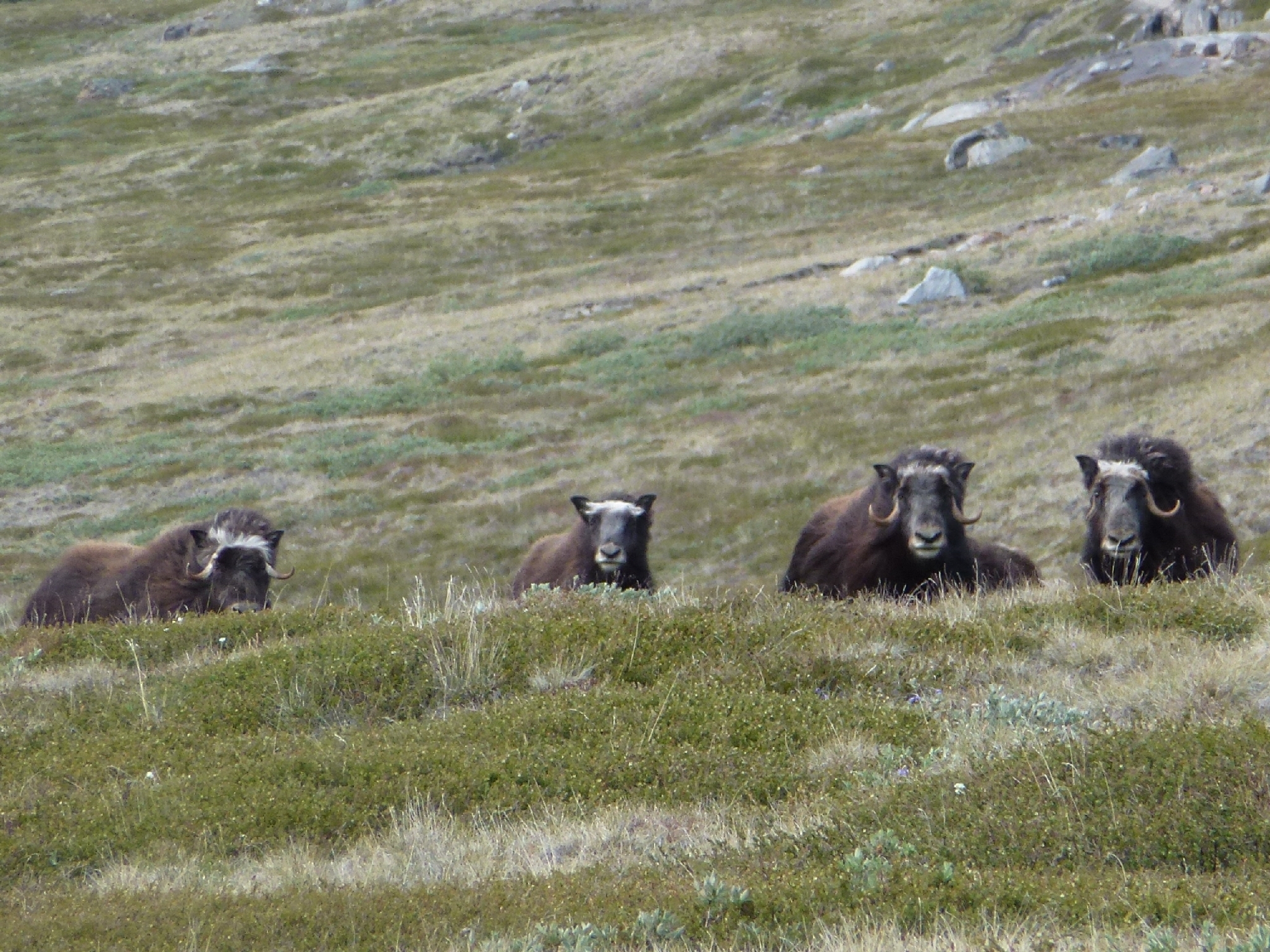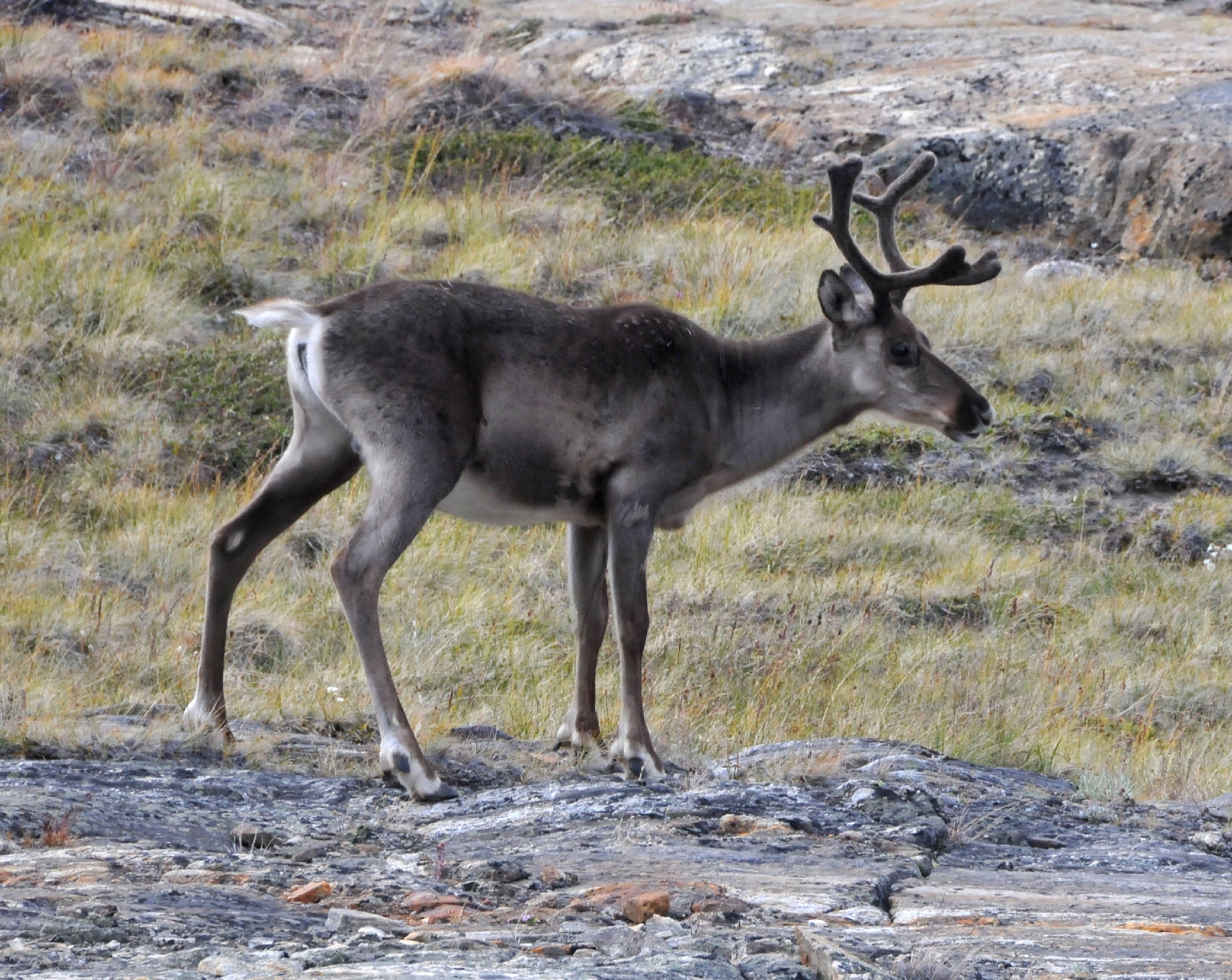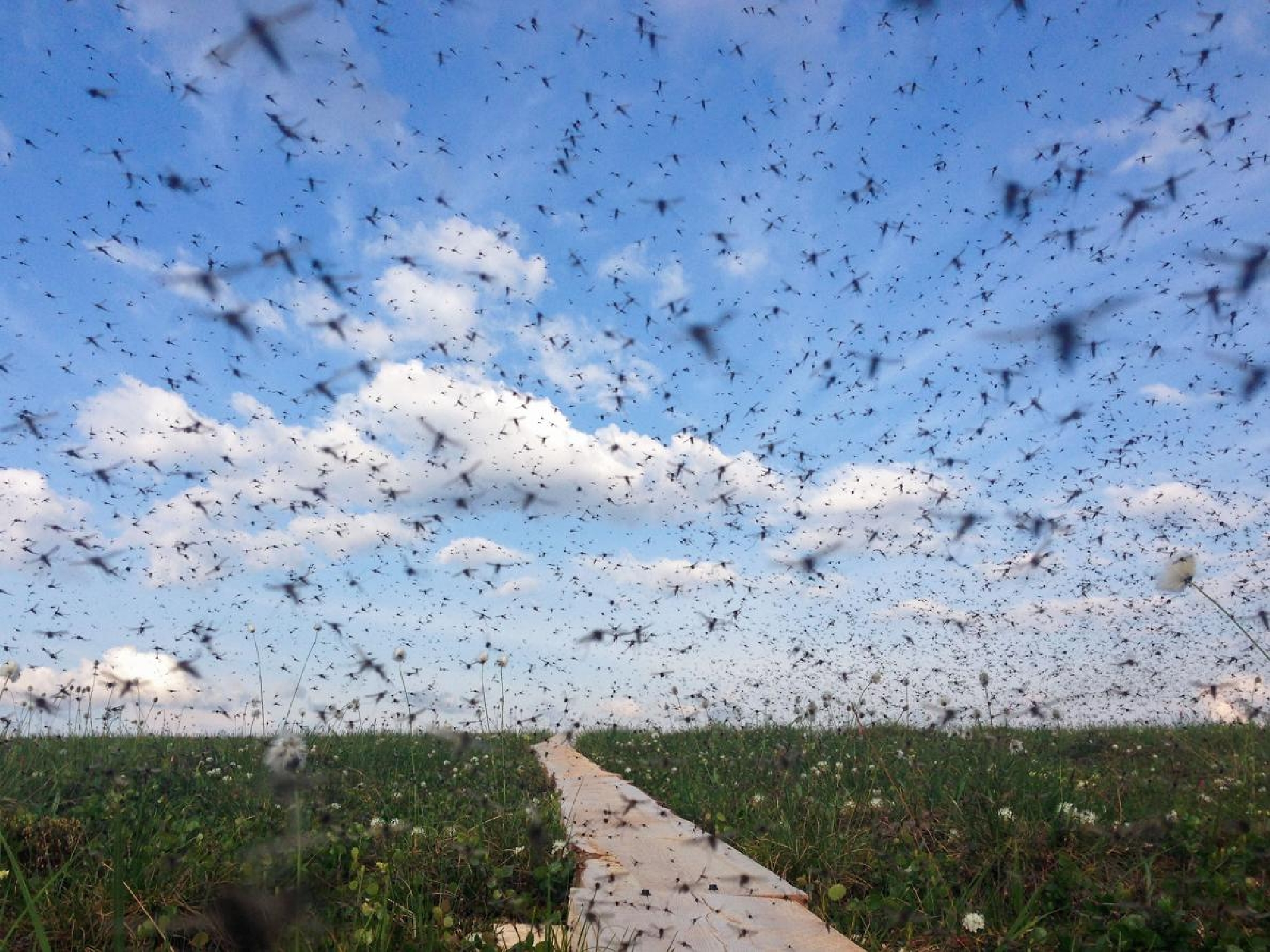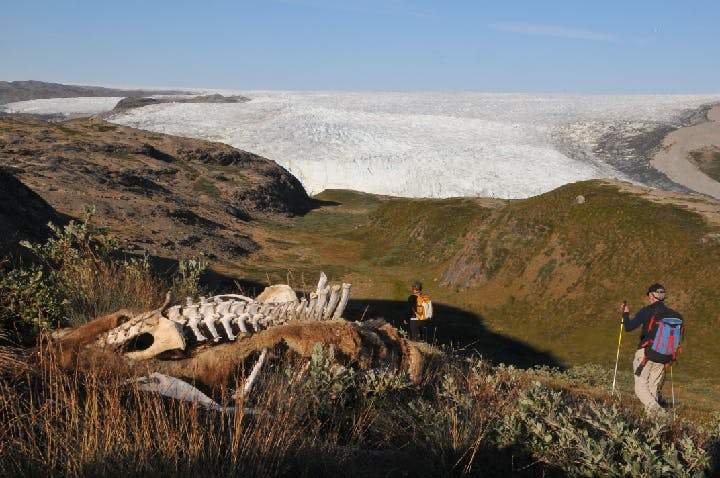Summer 2017
The Arctic Environment in the Age of Man
– Ross A. Virginia
The Arctic is hurtling into the Anthropocene, and caribou, walruses, and even mosquitoes are responding.
I’ve driven down this road every single summer for the past decade. It’s the longest road in Greenland, and it takes me from Kangerlussuaq, the international science hub, to the edge of the ice sheet, 40 km away. Today, as I approach Russell Glacier, I note a large section of ice that has recently collapsed into the river. The edge of the ice sheet is a striking mosaic of black-and-grey, sediment-covered ice with exposed facets of bright white and blue. My Dartmouth colleagues and I hike into a cold wind that sweeps across the Arctic tundra, filtering through the shrubs and grasses in its path. We carry equipment to measure plant growth and the amount of carbon dioxide escaping from warming soils – a positive feedback response that can accelerate global warming, affecting us all.
As we huddle near the ground to work, I notice, out of the corner of my eye, a distant group of muskoxen grazing near a lake. These prehistoric-looking animals slowly move toward us as they graze on the abundant, but low-quality, plant life. They stop about 100 meters away. There are eight of them: the dominant bull, a harem of six females, and a calf. We try to keep working, but it is difficult not to stop and admire this breathtaking scene. I wonder how Greenland, its people, and its unique flora and fauna will fare in the next decade and into the next century, when the full force of predicted changes in the Arctic environment takes hold.

A New Epoch
Never before has Arctic research been so important to understanding the earth’s environment and climate. Human domination of the planet’s ecosystems and the rapid increase in atmospheric greenhouse gases have caused scientists to propose that we now live in a new geological epoch, the Anthropocene (from the Greek anthropos, or human being). A relatively stable climate, which allowed agriculture to develop and human populations to flourish, characterized the previous epoch, the Holocene, which lasted for about 12,000 years. Since about 1950, man has permanently marked the geological record with human materials and legacies, such as radioactivity, plastics, and concrete. This footprint, which will be visible for millennia, is a sign of our new relationship with the planet. As for me, my brief life will straddle two geological epochs, an unenviable accomplishment caused by human exploitation of our environment and its natural resources. Here, above the Arctic Circle, the impact of the Anthropocene on the ground – on the flora, fauna, and ecosystems that fill this landscape – is undeniable and extremely sobering.
As for me, my brief life will straddle two geological epochs, an unenviable accomplishment caused by human exploitation of our environment and its natural resources.
Arctic warming, the primary cause of what ecologists like myself are observing here, has direct and indirect effects on biodiversity, the number of species living in the environment. Among the most-recognized animals of the High North is the caribou, or reindeer, as it is often called in Europe and Russia. Wild caribou can form large herds, and their migrations are the most spectacular of any mammal (excepting the great herds of the Serengeti plain in Africa). They are an essential natural resource for indigenous populations across the Arctic, providing food (meat and milk), materials for clothing and shelter, a means of transportation, and an emblem of cultural identity for indigenous groups such as the Saami and the Gwich’in. Although caribou are not endangered, declining numbers are a concern. Warming is now associated with large-scale mortality.

Bruce Forbes and his associates at the Arctic Centre at the University of Lapland have applied interdisciplinary techniques to get to the bottom of this trend and to examine how climate change is affecting the Nenets, nomadic reindeer herders in the Yamal region of Russia. In the winter of 2013, about 60,000 caribou in the region died of starvation, seriously disrupting Nenets society for years to come. Forbes’ research has shown that warming winters lessen sea ice coverage in the adjacent Barents Sea, leading to evaporation of sea water and an increase in moisture in the air. That, in turn, causes a phenomenon only rarely seen under colder conditions: during these so-called “rain-on-snow” events, rain falling out of season quickly freezes and forms an impenetrable ice layer within the snowpack. This ice prevents caribou from digging to the soil surface to feed on lichens, resulting in starvation. Climate change may decide the fate of the Nenets, a people who have sustained themselves on the tundra for centuries, but whose future is now uncertain.
What the Mosquitoes are Saying
There are many sounds that I associate with my time in the Arctic: people speaking Kalaallisut, or Greenlandic; loons calling on an unnamed lake near Kangerlussuaq; an Arctic fox yelping in the distance; meltwater cascading down the Watson River; and humpback whales bubble-feeding off of Baffin Island. None of these sounds, however, creates the immediate, visceral reaction provoked by the Arctic mosquito. No other ecosystem supports the same density and intensity of mosquito activity, in fact. The combination of an intense growing season spurred by constant light, abundant water, and other factors creates ideal conditions for the rapid growth and emergence of mosquitoes from Arctic ponds. In most places, of course, we seek to completely eliminate them in order to control the diseases they carry, such as malaria, dengue fever, and Zika virus. The Arctic, however, is probably the one environment where mosquitoes have a significant ecological role, as they pollinate plants and serve as a food source for aquatic and terrestrial organisms. That also makes them an ideal target organism to understand how climate change alters Arctic ecosystems and affects animals and people.

In our study of mosquitoes in Greenland, my colleagues and I found that warming speeds the development of the insects in ponds, which synchronizes their emergence with the brief period of caribou-calving. Biting mosquitoes can kill young calves and harass adults, who then feed less and suffer from lower body weight and reduced vigor. That means, of course, negative consequences not only for caribou, but also for the local communities that rely on them as a subsistence food resource. It’s also worth noting that out of about 3,500 species of mosquitoes worldwide, only two have been found in Greenland, neither of which is a disease vector. However, as Greenland warms and as more people travel in and out, it is likely that exotic species of many kinds will arrive, mosquitoes and otherwise. Some might take hold – with unpredictable consequences for nature and people.
‘The Right to Be Cold’
For many northern residents, the word “Arctic” is necessarily followed by “Ocean.” Indeed, the Arctic Ocean supports the most northern indigenous communities on earth, and they have flourished for millennia. I am a great admirer of Sheila Watt-Cloutier, an Inuit leader and climate change activist. In her book, The Right to Be Cold, she shows how our disruption of the global climate threatens the very roots of her native culture, which is truly anchored by the ice. Part of the cultural threat comes from the threat that faces several keystone species in the Arctic, those upon which others in the ecosystem largely depend. These include whales, walruses, polar bears, and many lesser-known species that depend on sea ice.
A top marine predator may be pushed to the terrestrial environment for its survival.
While the image of a lonely polar bear adrift on a small piece of ice has become the icon of climate change, walruses are also catching the attention of concerned scientists. They depend on sea ice as a platform on which to “haul out” in between dives in order to feed on clams and other bottom-dwelling organisms. As the ice disappears, walruses are forced to haul out on land. It is a fact that many of these sites are traditional. The United States and Russia recently published a joint database that synthesizes 160 years of information on the locations of historic haul-outs, all to help protect the sites from disturbance and pollution. However, the recent appearance of large, new haul-outs is surprising and disturbing. Thousands of walruses have arrived in densely packed groups on Alaska’s beaches, where they are vulnerable to overheating and forced to expend large amounts of energy swimming to and from feeding grounds. If disturbed, the walruses rush from the beach to the open water, sometimes crushing their young in the stampede. In some areas, polar bears, which depend on sea ice as a platform for hunting, are spending more time on land in locations where sea ice is less plentiful. These bears have resorted to eating sea-bird eggs in coastal rookeries, a pattern that could have serious consequences for bird populations. A top marine predator may be pushed to the terrestrial environment for its survival.

The Arctic defies a single definition. There are political boundaries, cartographic boundaries, and other delineators. However, I see the future Arctic as represented by the International Bathymetric Chart of the Arctic Ocean. It shows a very blue Arctic with the sea ice stripped away, transformed by declining ice and a regional rate of atmospheric warming twice that of the global average. Indeed, the Arctic is hurtling into the Anthropocene. The palette on land will shift too, with the growth of more green plants. What will this color-shifted future hold?
It is not useful to speak of winners and losers in these scenarios. Rather, we face a collective challenge and a responsibility to consider whether the Arctic has a “right to be cold.”
The ocean will have more life, but different life. Species from the south, transported by increased shipping and commerce, may arrive to take advantage of new habitats. This wave may alter the Arctic ecosystem, possibly at great cost to its current biodiversity and to species upon which residents of the Arctic depend. Ocean acidification from climate change and pollution from economic development and extractive industries will become challenging science and policy issues. Ice-dependent organisms will be pushed into spatially restricted habitats, the last ice refuges. For some species, a new equilibrium might be reached through alterations in food preferences. Others, however, will probably be lost locally or entirely. Yes, the increasing productivity of land and ocean might bring agriculture and fisheries to new locations, creating economic benefits and boosting food security. It is not useful to speak of winners and losers in these scenarios. Rather, we face a collective challenge and a responsibility to consider whether the Arctic has a “right to be cold.”
Arctic Citizens
During his term as U.S. special representative for the Arctic, retired Admiral Robert Papp, Jr. often said, “What happens in the Arctic doesn’t stay in the Arctic.” He correctly observed that the rapid and palpable changes in the Arctic climate and environment are a harbinger of what the rest of the world will soon face. The way I put it is this: we are all “Arctic citizens.” Much of this sounds – and is – dire, but I do also see the Arctic as a place of promise and opportunity. I have hope that our actions to slow, mitigate, and adapt to climate change in the Arctic can produce concrete results, which can inform and inspire the rest of the world.
The collective indigenous knowledge of Arctic societies is a global resource for understanding how resilience can form the foundation of our communities and social institutions. The Arctic Council, the indigenous peoples’ organizations of the circumpolar north, NGOs, and the private sector are finding areas for cooperation. Universities are investing more in Arctic studies and related curricula and are building interdisciplinary research programs focused on environmental change and sustainability. Innovative initiatives and research programs like the Fulbright Arctic Initiative and the Arctic Youth Ambassadors are building new and lasting collaborative networks. Such efforts are helping to train a new generation of Arctic leaders who are better equipped to solve big issues. If we are able to bring together the academic, public, and policy communities and mobilize collective action, then I see an Arctic that is changed, but hopeful.
* * *
Ross A. Virginia (@RVirginiaPolar) is director of the Institute of Arctic Studies and a professor of environmental science at Dartmouth College. He is also a global fellow at the Wilson Center’s Polar Initiative and has served as co-lead scholar for the Fulbright Arctic Initiative since its inception.
Cover photo of Ross Virginia (right) as he hikes past a muskox skeleton near Russell Glacier, Greenland, 2011 (courtesy of Ross Virginia)
